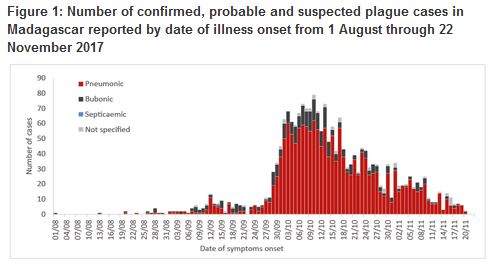

Credit CDC
#16,086
Although most people probably assume that plague has been eradicated - if not globally, at least in the United States - this scourge of the dark ages continues to spark outbreaks around the world, along with sporadic cases in the United States, every year.
Over the weekend news of the death of a 10 y.o. boy in La Plata County, Colorado made headlines, reminding us that plague remains endemic in animals in the rural west. On average, the United States sees about 7 human cases each year, although some years it can be twice that.
Since plague - which is caused by the bacteria Yersinia pestis - is treatable by antibiotics if caught early enough, deaths in the United States are rare. Globally, a couple of thousand plague cases are reported each year, mostly in rural areas of Africa, Asia, and South America, with Madagascar the hardest, and most consistently hit region.
- Bubonic Plague (Yersinia Pestis) - carried by rats, squirrels, and other small rodents, and transmitted by fleas - sets up in the lymphatic system, resulting in the tell-tale buboes, or swollen lymph glands in the the groin, armpits, and neck.
- Less commonly Pneumonic Plague may develop, when the infected individual develops a severe pneumonia, with coughing and hemoptysis (expectoration of blood), which may spread the disease by droplets from human-to-human.

While this outbreak - the worst since India's 1994 outbreak (summarized here) - was eventually contained, this came just 3 years after West Africa's Ebola epidemic demonstrated its ability to spread in an urban environment.
While we've not seen an urban outbreak in the United States for nearly 100 years (1924 - Los Angeles), two summers ago - in CDC: The 8 Zoonotic Diseases Of Most Concern In The United States - we looked at a joint CDC, USDA, DOI report on the top (n=56) zoonotic diseases of national concern for the United States (see chart below) which listed plague as still being number 5 on their hit parade.
Below you'll find the plague advisory from Colorado public health, with tips on how to avoid exposure. I'll have a brief postscript after the break.
Plague activity identified in Colorado
FOR IMMEDIATE RELEASE
CONTACT: AnneMarie Harper
Email: annemarie.harper@state.co.us
Plague activity identified in Colorado
Know the symptoms to stay safe
(REMOTE, July 22, 2021): Colorado Department of Public Health and Environment, in cooperation with local public health agencies, is investigating plague (Yersinia pestis) activity. Currently, there have been laboratory confirmed reports of plague in animals and fleas from six counties. This includes LaPlata County, where a 10-year-old resident died from causes associated with plague. Laboratory testing has since confirmed the presence of plague in a sample of fleas collected in the county. CDPHE wants people to learn about plague and take precautions.
Plague is caused by bacteria (Yersinia pestis) that can be transmitted to humans by the bites of infected fleas or by direct contact with infected animals. Plague is frequently detected in rock squirrels, woodrats, and other species of ground squirrels and chipmunks. Prairie dogs are very susceptible to plague. Since they are active above ground, if they suddenly disappear, they serve as a visible alert that plague may be present. If you notice decreased rodent activity in an area where you normally see active rodents, contact your local public health agency. Residents should not kill prairie dogs on their property. If plague is present this could increase the risk of transmission and contracting plague.Pets can also be infected with plague by infected fleas. The use of veterinary-approved flea control products is strongly advised.If detected early in infection, plague is treatable in both people and pets. Symptoms include the sudden on-set of high fever and/or swollen lymph nodes.“In Colorado, we expect to have fleas test positive for plague during the summer months. Awareness and precautions can help prevent the disease in people. While it’s rare for people to contract plague, we want to make sure everyone knows the symptoms. The disease is treatable if caught early. Let a medical provider know if you think you have symptoms of plague or if you think you’ve been exposed,” said Jennifer House, Deputy State Epidemiologist and Public Health Veterinarian for CDPHE.The risk of contracting certain animal-borne diseases, while present year-round, increases during the summer when humans and animals are frequently in close contact. Most human plague cases are acquired directly from fleas. Control the presence of wildlife and fleas around homes through the following measures:
- Avoid fleas. Protect pets with a veterinary approved flea treatment and keep them on a leash and out of wild rodent habitats.
- Stay out of areas where wild rodents live. If you enter areas inhabited by wild rodents, wear insect repellent and tuck your pant cuffs into your socks to prevent flea bites.
- Avoid all contact with wild rodents, including squirrels. Do not feed or handle them.
- Do not touch sick or dead animals.
- Prevent rodent infestations around your house by clearing plants and materials away from outside walls, reducing access to food items, and setting traps.
- Consult with a professional pest control company to treat the area around your home for fleas.
- Contact a veterinarian if your pet becomes ill with a high fever and/or an abscess (i.e. open sore) or swollen lymph nodes. Pets with plague can transmit the illness to humans.
- Children should be aware of these precautions and know to tell an adult if they have had contact with a wild animal or were bitten by fleas.
For more information, visit the department’s animal-related diseases webpage.
A highly recommended read (if you can find a copy) for both history and epidemic aficionados.


